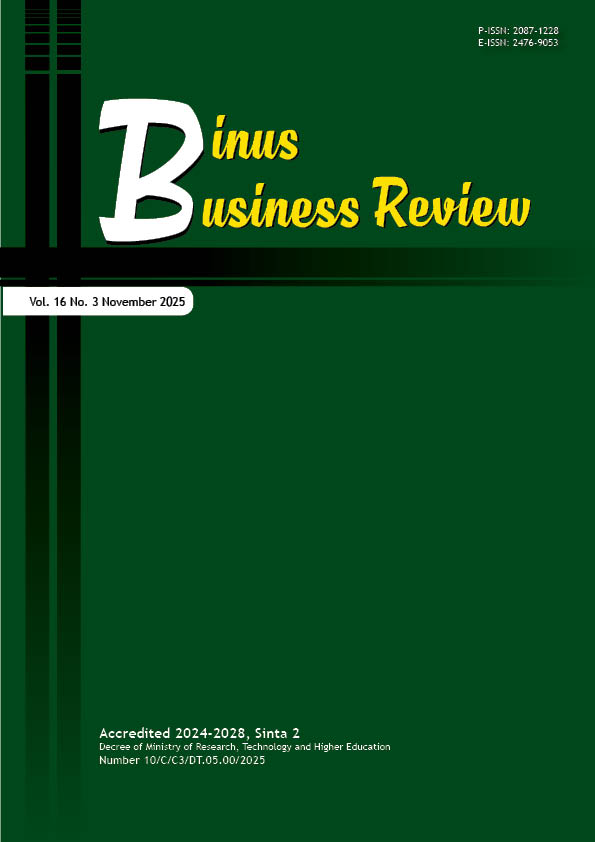Exploring the Role of Experiential and Emotional Marketing in Building Customer Satisfaction and Loyalty in Coffee Shop
DOI:
https://doi.org/10.21512/bbr.v16i3.13594Keywords:
experiential marketing, emotional marketing, customer satisfaction, customer loyalty, coffee shopAbstract
The research explored the role of experiential and emotional marketing in enhancing customer satisfaction and loyalty within Bali’s competitive coffee shop industry. With the rapid growth of coffee shops in Bali, particularly Gen Z consumers who prioritized experiences and emotional connections, the research investigated how these marketing strategies influenced consumer behavior. Drawing on data from 183 customers of a prominent coffee shop in Denpasar, the researchers employed Multilayer Partial Least Squares Structural Equation Modeling (PLS-SEM) to analyze the relationships between experiential marketing, emotional marketing, customer satisfaction, and customer loyalty. The findings reveal that both experiential and emotional marketing have a significant positive impact on customer satisfaction. Furthermore, experiential marketing and emotional marketing also directly influence customer loyalty. Importantly, customer satisfaction ensures that consumers feel fulfilled with the value they receive, which in turn strengthens long-term loyalty toward the brand. These insights underscore the importance of creating immersive, emotionally resonant experiences that align with the values and lifestyles of modern consumers. For practitioners, the research recommends designing sensory-rich environments, fostering emotional brand connections, and leveraging storytelling to enhance customer retention. From an academic perspective, the research contributes to a deeper understanding of consumer behavior in experiential service industries, particularly in a tourism-driven market like Bali. Future studies should consider broader demographic samples and longitudinal designs further to explore the evolving dynamics of customer satisfaction and loyalty.
References
Aboulnasr, K., & Tran, G. A. (2020). Is love really blind? The effect of emotional brand attachment on the perceived risk of really new products. Journal of Product & Brand Management, 29(1), 81–96. https://doi.org/10.1108/JPBM-09-2018-2005
Akinsolu, M. O., & Zribi, K. (2023). A generalized framework for adopting regression-based predictive modeling in manufacturing environments. Inventions, 8(1), 1–32. https://doi.org/10.3390/inventions8010032
Arcana, P. F. (2021, April 26). Kedai kopi tumbuh bersama petani. Kompas. https://www.kompas.id/baca/gaya-hidup/2021/04/26/kedai-kopi-tumbuh-bersama-petani?open_from=Tagar_Page
Alaoui, M. M., & Ouhna, L. (2024). Exploring customer loyalty in Islamic traditional markets: Insights from relationship marketing and experiential marketing theories. In Springer Proceedings in Business and Economics (pp. 141–164). Springer. https://doi.org/10.1007/978-981-97-5400-7_9
Arora, M. (2025). Brand building in the age of sensory marketing: A strategic perspective. In R. Malik, S. Malhan, & M. Arora (Eds.), Impact of sensory marketing on buying behavior (pp. 367–382). IGI Global Scientific Publishing. https://doi.org/10.4018/979-8-3693-9351-2.CH016
Azzahra, A., & Sudirman, I. D. (2025). Forecasting daily sales of coffee shop products: A comparative study of moving average, ARIMA, and SARIMA. In 2025 International Conference on Data Science and Its Applications (ICoDSA 2025) (pp. 345–349). IEEE. https://doi.org/10.1109/ICoDSA67155.2025.11157384
Barrientos-Báez, A., Caldevilla-Domínguez, D., & Fondevila-Gascón, J. F. (2025). Neurocommunicational effects of nostalgia in advertising: Impact and emotional connection with the consumer [Efectos neurocomunicacionales de la nostalgia en la publicidad: Impacto y conexión emocional con el consumidor]. European Public & Social Innovation Review, 10, 1–27. https://doi.org/10.31637/epsir-2025-1861
Basmantra, I. N., & Putra, P. A. P. (2024). The analysis of visual appearance of coffee product packaging on the purchase decisions and brand image competition. In Proceedings of the International Conference on Business and Technology (ICBT2023) (pp. 422–429). Springer. https://doi.org/10.1007/978-3-031-55911-2_41
Bayır, T. (2022). Experiential marketing and practices: The perspective of customer satisfaction and loyalty. In G. Akel (Ed.), Handbook of research on interdisciplinary reflections of contemporary experiential marketing practices (pp. 143–165). IGI Global Scientific Publishing. https://doi.org/10.4018/978-1-6684-4380-4.ch008
Bhatti, H. S., Abareshi, A., & Pittayachawan, S. (2020). Development of a theoretical framework for customer loyalty in australia. In International Conference of Reliable Information and Communication Technology (pp. 1061–1075). Springer International Publishing. https://doi.org/10.1007/978-3-030-33582-3_100
Bishnoi, S. K., & Singh, S. (2022). A study on consumer buying behaviour for fashion and luxury brands under emotional influence. Research Journal of Textile and Apparel, 26(4), 405–418. https://doi.org/10.1108/RJTA-03-2021-0026
Bui, D. L., & Nguyen, H. H. (2022). Sensory marketing on customers’ satisfaction: A tale from the second largest coffee exporter. International Journal of Economics and Business Research (IJEBR), 23(1). https://doi.org/10.1504/IJEBR.2022.119336
Cataldo, R., Grassia, M. G., & Lauro, C. N. (2023). Alternative approaches to higher order PLS path modeling: A discussion on methodological issues and applications. In H. Latan, J. F. Hair, & R. Noonan (Eds.), Partial Least Squares Path Modeling: Basic Concepts, Methodological Issues and Applications (pp. 229–266). Springer International Publishing. https://doi.org/10.1007/978-3-031-37772-3_9
Chiengkul, W., & Junla, J. (2024). Have you been falling in love?: An analysis of coffee shop brand love in Thailand. Journal of Foodservice Business Research, 27(1), 61–86. https://doi.org/10.1080/15378020.2023.2229577
Choi, C. J., Xu, J., & Min, D. G. (2024). Investigating of the influence process on consumer’s active engagement through emotional brand attachment and brand love. Asia Pacific Journal of Marketing and Logistics, 36(11), 3061–3080. https://doi.org/10.1108/APJML-10-2023-1028
Coico, K. E. A. B, Rufasto, M. B. L., Valderrama-Puscan, M. W., Wong, S. I. D., Merino, M. E. P., & Velásquez, F. A. Z. (2024). Experiential marketing and customer loyalty in Peruvian companies: D’Pùlpa case. In 22nd LACCEI International Multi-Conference for Engineering, Education, and Technology: Sustainable Engineering for a Diverse, Equitable, and Inclusive Future at the Service of Education, Research, and Industry for a Society 5.0. https://doi.org/10.18687/LACCEI2024.1.1.591
Cronin, M. T. D., Basiri, H., Chrysochoou, G., Enoch, S. J., Firman, J. W., Spînu, N., & Madden, J. C. (2025). The predictivity of QSARs for toxicity: Recommendations for improving model performance. Computational Toxicology, 33, 1–12. https://doi.org/10.1016/j.comtox.2024.100338
Ding, L., & Jiang, C. (2025). The impact of rural tourism destination attractiveness on tourists’ environmentally responsible behavioral intentions: The mediating role of green self-identity. Journal of Global Responsibility, 16(1), 1–21. https://doi.org/10.1108/JGR-03-2023-0046
Dos Santos, P. M., & Cirillo, M. Â. (2023). Construction of the average variance extracted index for construct validation in structural equation models with adaptive regressions. Communications in Statistics - Simulation and Computation, 52(4), 1639–1650. https://doi.org/10.1080/03610918.2021.1888122
Fakhreddin, F. (2021). What we buy and how we feel: The impacts of consumers’ purchases on their happiness. In Understanding emotions. Nova Science Publishers, Inc. https://www.scopus.com/pages/publications/85129866210?origin=scopusAI
Ferrentino, R., & Boniello, C. (2020). Customer satisfaction: A mathematical framework for its analysis and its measurement. Computational Management Science, 17, 23–45. https://doi.org/10.1007/s10287-018-0305-1
Gunawan, W., & Chandra, Y. U. (2024). Analysis of customer loyalty from users who bought coffee using online food delivery application. In 2024 International Conference on ICT for Smart Society (ICISS) (pp. 1–6). https://doi.org/10.1109/ICISS62896.2024.10751005
Hair Jr., J. F. ., Sarstedt, M., Ringle, C. M., & Gudergan, S. S. (2023). Advanced issues in partial least squares structural equation modeling. SAGE.
Handique, K., & Sarkar, S. (2024). The impact of brand love on customer loyalty: Exploring emotional connection and consumer behaviour. International Research Journal of Multidisciplinary Scope (IRJMS), 5(4), 1104–1120. https://doi.org/10.47857/IRJMS.2024.V05I04.01723
Irgui, A., Qmichchou, M., & El Haraoui, I. (2024). A systematic review of augmented reality experiential marketing: Conceptual framework and research Agenda. In L. Alla, A. Hmioui, & B. Bentalha (Eds.), AI and data engineering solutions for effective marketing (pp. 87-113). IGI Global Scientific Publishing. https://doi.org/10.4018/979-8-3693-3172-9.ch005
Jiang, Y., Sun, Y., & Tu, S. (2023). Economic implications of emotional marketing based on consumer loyalty of mobile phone brands: The sequential mediating roles of brand identity and brand trust. Technological and Economic Development of Economy, 29(4), 1318–1335. https://doi.org/10.3846/tede.2023.19278
Jindal, A., Jindal, P., & Chavan, L. (2023). Customer engagement through emotional branding. In Promoting consumer engagement through emotional branding and sensory marketing (pp. 201–210). IGI Global Scientific Publishing.
Junaidi, J., Ardiya, A., & Anugrah, P. (2022). Coffee shops as space for the cultural production in urban society. Wisdom, 22(2), 50–58. https://doi.org/10.24234/wisdom.v22i2.760
Khan, I., Fatma, M., Kumar, V., & Amoroso, S. (2021). Do experience and engagement matter to millennial consumers? Marketing Intelligence & Planning, 39(2), 329–341. https://doi.org/10.1108/MIP-01-2020-0033
Kosasih, O., Hidayat, K., Hutahayan, B., & Sunarti. (2024). Achieving sustainable customer loyalty in the petrochemical industry: The effect of service innovation, product quality, and corporate image with customer satisfaction as a mediator. Sustainability, 16(16), 1–24. https://doi.org/10.3390/su16167111
Krishnan, J. J. (2020). A study on loyalty dimension and measurement. Materials Today: Proceedings, 37(Part 2), 890–893. https://doi.org/10.1016/j.matpr.2020.06.046
Le, B. N., & Nguyen, N. (2024). The impact of perceived value on consumers’ positive word-of-mouth intention toward energy-efficient appliances. International Journal of Energy Economics and Policy, 14(2), 383–393. https://doi.org/10.32479/ijeep.15655
Lee, K., & Jun, H. P. (2025). The relationship between service recovery fairness, customer emotional responses and customer behavioral responses in fitness clubs. Journal of Asian Scientific Research, 15(1), 136–146. https://doi.org/10.55493/5003.V15I1.5335
Lee, T. C., & Peng, M. Y. P. (2021). Green experiential marketing, experiential value, relationship quality, and customer loyalty in environmental leisure farm. Frontiers in Environmental Science, 9, 1–15. https://doi.org/10.3389/fenvs.2021.657523
Lee, W., Seo, Y., & Quan, L. (2024). Consumer behavior toward eco-friendly coffee shops: moderating effect of demographic characteristics. Journal of Foodservice Business Research, 27(6), 951–975. https://doi.org/10.1080/15378020.2023.2214059
Levy, S., & Gendel Guterman, H. (2021). Twofold impact of experiential marketing: Manufacturer brand and hosting retailer. EuroMed Journal of Business, 16(4), 345–360. https://doi.org/10.1108/EMJB-03-2020-0028
Madathil, J. C., & Murugan, N. (2024). Actions speak louder than words: Brand activism effort effect on brand outcomes. Journal of Marketing Communications, 1–26. https://doi.org/10.1080/13527266.2024.2431913
Maydeu-Olivares, A., Shi, D., Pavlov, G., & Ferraz, R. (2023). Model-data fit evaluation: Item fit and model selection. In International Encyclopedia of Education (Fourth edition) (pp. 260–272). Elsevier Inc. https://doi.org/10.1016/B978-0-12-818630-5.10036-3
Miranda-Guerra, M. D. P., Hoyos-Yrigoyn, N. D., Carrillo-Carranza, L. B., Karina, E., & Terrones-Becerra. (2022). Relationship between experiential marketing and customer satisfaction in the retail sector. IBIMA Business Review, 2022, 1–10.
Nayak, A., & Satpathy, I. (2024). The sensory marketing theory: A journey into multisensory marketing. In Sensible selling through sensory neuromarketing (pp. 43–67). IGI Global.
Nazarian, A., Shabankareh, M., Ranjbaran, A., Sadeghilar, N., & Atkinson, P. (2024). Determinants of intention to revisit in hospitality industry: A cross-cultural study based on globe project. Journal of International Consumer Marketing, 36(1), 62–79. https://doi.org/10.1080/08961530.2023.2192537
Oey, E., Dimitri, Husin, M., & Nurcahyo, R. (2025). Consumer preference model for coffee beverages - A case of Greater Jakarta consumers. International Journal of Business Excellence, 36(1), 1–30. https://doi.org/10.1504/IJBEX.2025.146058
Owusu, S. O., & Kankam, G. (2025). Managing customer happiness through service trust and service commitment: The mediating role of customer experience. SN Business & Economics, 5. https://doi.org/10.1007/S43546-025-00840-9
Patwa, N., Hamelin, N., & Tarabasz, A. (2022). Emotionally engaging customers through storytelling. In Promoting consumer engagement through emotional branding and sensory marketing (pp. 178–200). IGI Global. https://doi.org/10.4018/978-1-6684-5897-6.ch015
Pérez Mendoza, W. W. O., Díaz Fernández, R. A., D’angelo-Panizo, M. D. C., & Obando Peralta, E. C. (2024). Relationship marketing in financial institutions: Emotional customer loyalty as a management objective [Marketing relacional en entidades financieras: La fidelización emocional del cliente como propósito de gestión]. Revista de Ciencias Sociales, 30(3), 504–516. https://doi.org/10.31876/rcs.v30i3.42692
Prentice, C., Dominique-Ferreira, S., Ferreira, A., & Wang, X. (2022). The role of memorable experience and emotional intelligence in senior customer loyalty to geriatric hotels. Journal of Retailing and Consumer Services, 64. https://doi.org/10.1016/j.jretconser.2021.102788
Rashid, N., Nika, F. A., & Thomas, G. (2021). Impact of service encounter elements on experiential value and customer loyalty: An empirical investigation in the coffee shop context. SAGE Open, 11(4), 1–12. https://doi.org/10.1177/21582440211061385
Ravula, P., Jha, S., & Biswas, A. (2022). Relative persuasiveness of repurchase intentions versus recommendations in online reviews. Journal of Retailing, 98(4), 724–740. https://doi.org/10.1016/j.jretai.2022.06.001
Riswara, E. P., Wagiman, & Purwadi, D. (2021). The strategy of increasing customer satisfaction of coffee shop in Yogyakarta through GAP analysis. In IOP Conference Series: Earth and Environmental Science. https://doi.org/10.1088/1755-1315/828/1/012061
Salomão, M. T., & Santos, M. A. (2022). The impact of experiential marketing on the intention to revisit the brand: Comparing large and small fast-food restaurant chains [O impacto do marketing experiencial na intenção de revisitar a marca: uma comparação entre grandes e pequenas redes de restaurantes fast-food]. Brazilian Journal of Marketing, 21(3), 730–783. https://doi.org/10.5585/REMARK.V21I3.21331
Soliha, E., Aquinia, A., Hayuningtias, K. A., & Ramadhan, K. R. (2021). The influence of experiential marketing and location on customer loyalty. Journal of Asian Finance, Economics and Business, 8(3), 1327–1338. https://doi.org/10.13106/JAFEB.2021.VOL8.NO3.1327
Statista. (2025). Market value coffee shop market in the United States from 2018 to 2022 (In billion U.S. dollars). https://www.statista.com/statistics/1032200/coffee-shop-industry-market-size-us/
Urdea, A. M., & Constantin, C. P. (2021). Experts’ perspective on the development of experiential marketing strategy: Implementation steps, benefits, and challenges. Journal of Risk and Financial Management, 14(10), 1–15. https://doi.org/10.3390/JRFM14100502
Verbeke, W. J. M. I., Gijsenberg, M. J., Hendriks, L. M. E., Bouma, J. T., & Teunter, L. H. (2020). Highly recommended? How relation-specific attachment styles bias customers willingness to recommend. Frontiers in Psychology, 11, 1–16. https://doi.org/10.3389/fpsyg.2020.01311
Wang, J., Xu, S., Zhang, S., Sun, C., & Wu, L. (2023). Research on the impact of consumer experience satisfaction on green food repurchase intention. Foods, 12(24), 1–15. https://doi.org/10.3390/foods12244510
Wang, X. (2025). A study of the relationship between sensory marketing strategies and customer loyalty in experiential retail environments. Journal of Combinatorial Mathematics and Combinatorial Computing, 127a, 381–394. https://doi.org/10.61091/JCMCC127A-023
Wei, X., Huang, J., Zhang, L., Pan, D., & Pan, J. (2022). Evaluation and comparison of SEM, ESEM, and BSEM in estimating structural models with potentially unknown cross-loadings. Structural Equation Modeling, 29(3), 327–338. https://doi.org/10.1080/10705511.2021.2006664
Wu, J., Wu, T., & Schlegelmilch, B. B. (2020). Seize the day: How online retailers should respond to positive reviews. Journal of Interactive Marketing, 52(1), 52–60. https://doi.org/10.1016/j.intmar.2020.04.008
Downloads
Published
How to Cite
Issue
Section
License
Copyright (c) 2025 Rifqi Nur Fakhrurozi, Nyoman Indah Kusuma Dewi, Putu Adriani Prayustika, Ida Ayu Putri Widiasuari Riyasa

This work is licensed under a Creative Commons Attribution-ShareAlike 4.0 International License.
Authors who publish with this journal agree to the following terms:
a. Authors retain copyright and grant the journal right of first publication with the work simultaneously licensed under a Creative Commons Attribution License - Share Alike that allows others to share the work with an acknowledgment of the work's authorship and initial publication in this journal.
b. Authors are able to enter into separate, additional contractual arrangements for the non-exclusive distribution of the journal's published version of the work (e.g., post it to an institutional repository or publish it in a book), with an acknowledgment of its initial publication in this journal.
c. Authors are permitted and encouraged to post their work online (e.g., in institutional repositories or on their website) prior to and during the submission process, as it can lead to productive exchanges, as well as earlier and greater citation of published work.
USER RIGHTS
All articles published Open Access will be immediately and permanently free for everyone to read and download. We are continuously working with our author communities to select the best choice of license options, currently being defined for this journal as follows: Creative Commons Attribution-Share Alike (CC BY-SA)





















